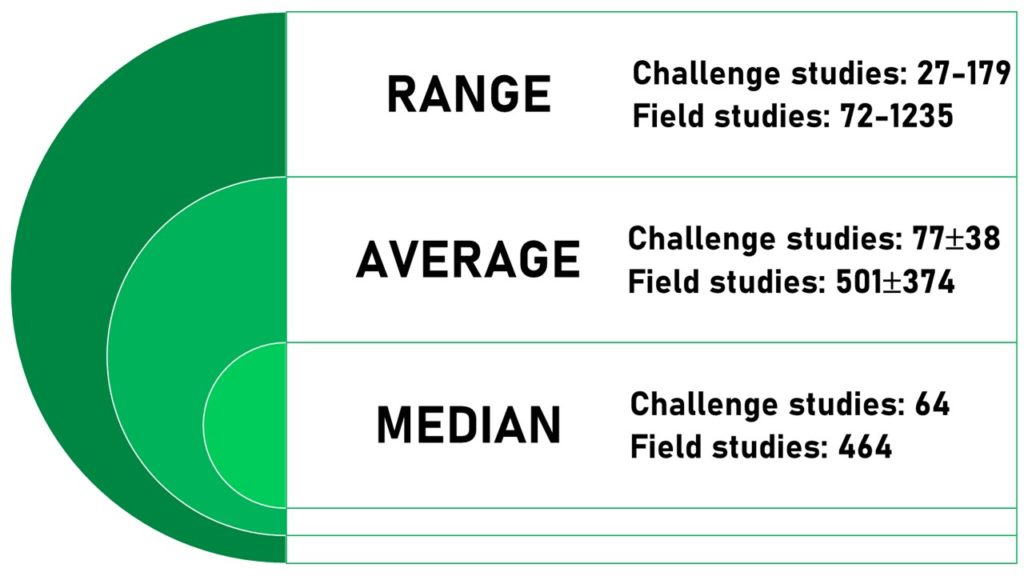Human challenge studies or controlled human infection model (CHIM) studies are Phase Ib or Phase IIa clinical trials, in which study participants, i.e. healthy volunteers, are deliberately exposed to infectious agents, to better understand the mechanism of infection or disease and test new therapies or vaccines (1). In 2017, World Health Organization has released guidelines on the regulatory considerations of human challenge trials for vaccine development (2). These guidelines detail the core aspects of CHIM studies and list over 10 potential purposes of human challenge study conduct.
It is worth acknowledging, that human challenge studies are not mandatory by the regulations, and therefore, it is not required to include them in clinical development programs of vaccines and antivirals by default. However, there is a growing interest by Pharma and Biotech companies to conduct CHIM studies (3), and there is a noticeable increase in such clinical trials each year. This is a result of certain significant advantages of challenge studies and their recognition by drug developers. So what are those benefits in a nutshell?
Human challenge studies:
This article will dig deeper into the first 5 benefits listed above and explain each of them in more detail.
Even though human challenge studies might seem to be at a higher risk level to trial participants, these studies are safe and very well controlled. Safety is the number one priority in any clinical trial. And for human challenge studies, there are extra miles taken to ensure that the informed consent process is thorough and that the participants of such studies clearly understand the risks related not only to the investigational medicinal product but also to the pathogen challenge itself (1).
The highly controlled environment in the human challenge study setting is another important element, which brings extra safety. In a CHIM study, a well-characterized, epidemiologically relevant strain of an infectious agent is administered in a controlled dose by a specific route to carefully selected and consenting healthy adult volunteers (4). Healthy volunteers are admitted to the quarantine unit a couple of days before the pathogen administration, and a thorough medical examination is performed. Staff performing those studies know exactly what dose of the pathogen was administered, at what exact time, and when the onset of the disease and symptoms are expected.
This controlled environment has another benefit. It brings high accuracy for the clinical trial data, which could never be achieved in field studies. Also, the amount and extent of data you can collect from a subject who stays in the individual quarantine ward for 1 or 2 weeks depending on the pathogen are invaluable. This gives the power to Pharma and Biotech companies to make data-driven and highly informed decisions on the further development of the drug or vaccine.
An important safety component of CHIMs to minimize the risk of the volunteers developing severe complications is the availability of curative treatments (3). A good example is malaria CHIM studies, where only treatment-sensitive malaria strains are used resulting in the absence of life-threatening disease in any of the study participants (5).
As mentioned before, the WHO guidelines list numerous purposes, why human challenge studies shall be considered. These purposes include:
The core element in human challenge studies that differentiates them from field clinical trials is a highly controlled environment. Critics may say it is artificial and that you cannot replicate the same conditions in real life. However, such data can prepare your product for further success and shape your further field studies in the right direction.
In challenge studies or controlled human infection model (CHIM) studies you know exactly when the study participant will be challenged with the pathogen. Therefore, in the same study, you can test different settings such as pre and post-exposure prophylaxis, different treatment regimens, etc. This allows for making data-driven and highly informed decisions when designing large Phase III clinical trials (2). This is also one of the main reasons, why CHIM studies are gaining more traction in recent years.
It is also worth mentioning that in challenge studies, healthy volunteers stay in the quarantine unit for a significant period of time, which allows the collection of samples on a daily basis and at a required frequency. This identifies how the disease is progressing and what the effect of the IMP looks like at any point in time.
The benefit of a smaller sample size required is the easiest to demonstrate with real-life examples. When analyzing Phase II study data from clinicaltrials.gov, of already completed studies in Respiratory syncytial virus (RSV) indication (6), which included studies, which only recruited adults or the elderly and excluded those, which enrolled infants, pregnant women, and transplant patients.
The result speaks for itself. Out of 29 studies included in the analysis, 13 were challenge studies, and 16 were field studies. The average sample size in RSV challenge studies was 77 subjects (range 27-179), while the average sample size in field studies was 501 subjects (range 72-1235).

The smaller sample size is a huge factor for the shorter total study duration as well as the relatively lower associated costs. It also allows to get the efficacy results promptly and therefore, move the product to the market faster.
Those who work in the vaccine and drug development in infectious diseases and particularly in the area of seasonal infections (such as the common cold, Influenza, RSV, Pneumonia, and now SARS-CoV-2) know that the timing of clinical trial start is of core importance. If you have missed the season due to some delays even by one month, your recruitment can be at high risk. You might end up chasing the season in the other hemisphere, opening new countries and sites in a different part of the world to recruit the required number of subjects for the clinical trial. This of course results in overall development delays and increased costs.
Human challenge studies can be conducted without any constraints related to the infection season. These studies are carried out all year round and this gives a significant advantage and confidence to Pharma and Biotech companies, that they will get the efficacy results of their investigational medicinal product despite what is happening outside of the quarantine unit. Such an outcome could not be achieved in any other setting.
A couple of important aspects of challenge trials allow for obtaining efficacy data faster than in regular Phase II field studies. This relates to a couple of human challenge study benefits described earlier. First of all, the smaller sample size required directly converts into a shorter time needed for healthy volunteer recruitment. Secondly, if done right, the recruitment of healthy volunteers can be much easier than finding patients with a specific disease.
In addition, a controlled human infection model study can be conducted immediately after obtaining Phase I data, without delay concerning the infection seasonality. Also worth mentioning is that CHIM studies are usually conducted at a single site, while even a small Phase IIa field study might require opening multiple countries and investigational sites to get the recruitment going. This might result in additional delays due to differences in regulatory processes across different regions.
Some recent examples in RSV vaccine development support this benefit even further. Front runners in this race Pfizer, Janssen, and Bavarian Nordic all obtained breakthrough designation status from the Food and Drug Administration in the US for their RSV vaccines after conducting human challenge studies (7-9). Such designation provides additional time saving for development programs and brings them closer to the expected marketing authorization.
Conclusion
To summarise, due to the significantly increased interest in clinical development programs in infectious diseases combined with the clear benefits of human challenge studies, we are noticing that they are building a strong momentum, which may become even higher moving forward.
We will discuss the rest of the advantages of CHIM studies in my next article. Make sure to follow and engage with your insights!
References:

Egle is a pharmacist by training, started her career in academia teaching basic pharmacology at university while she was doing her Ph.D. in preclinical stem cell research in nephrotoxicity. Egle is an author of 5 scientific papers, a winner of over 10 scientific awards and scholarships, 2 science grants. 8 years ago, Egle has joined CRO industry, where she mainly focused on business development in early clinical research and regulatory affairs. In April 2022, Egle became part of hVIVO – a world leader in human challenge studies. She is responsible for business development across Europe and the Asia Pacific, as well as expanding service portfolio beyond challenge study offering.
Sign up to our emails and follow us on social media to keep up to date with hVIVO.